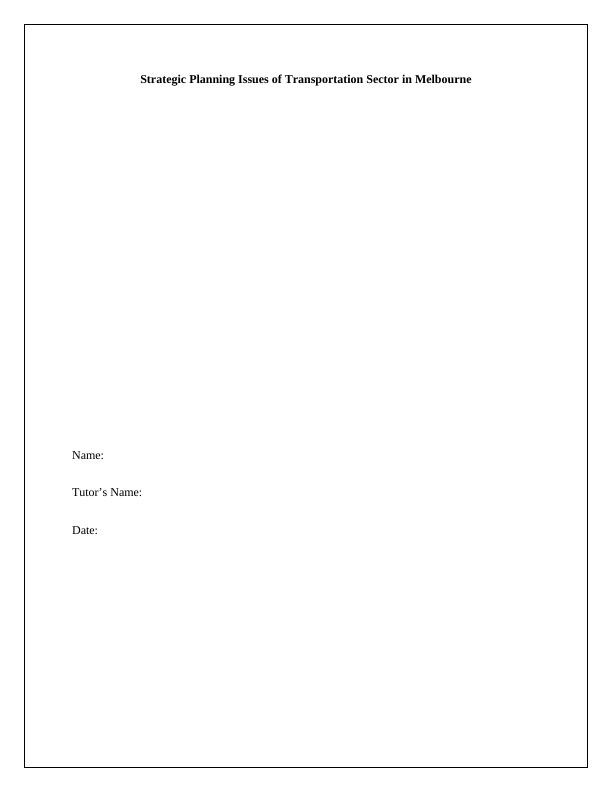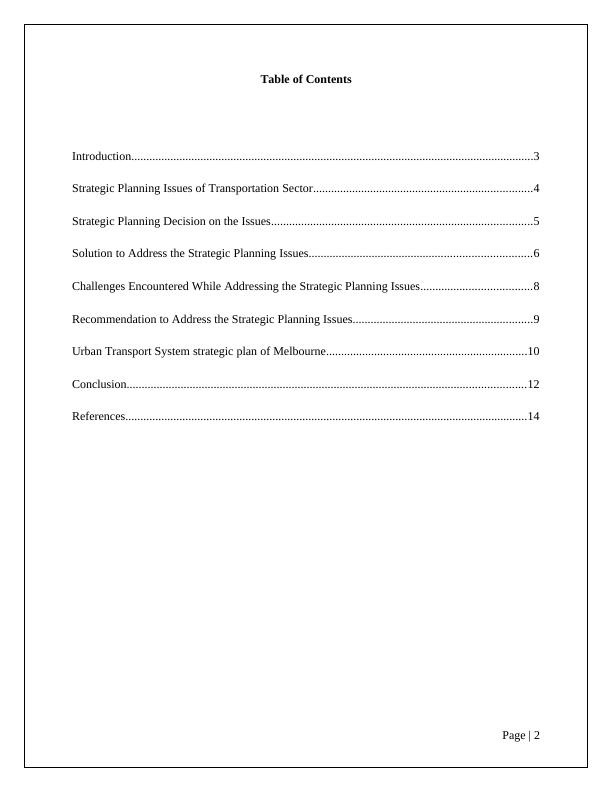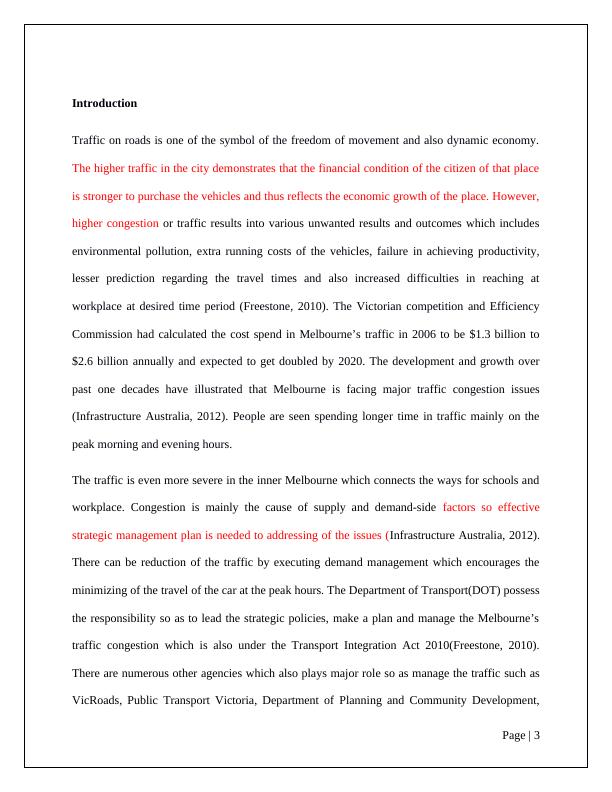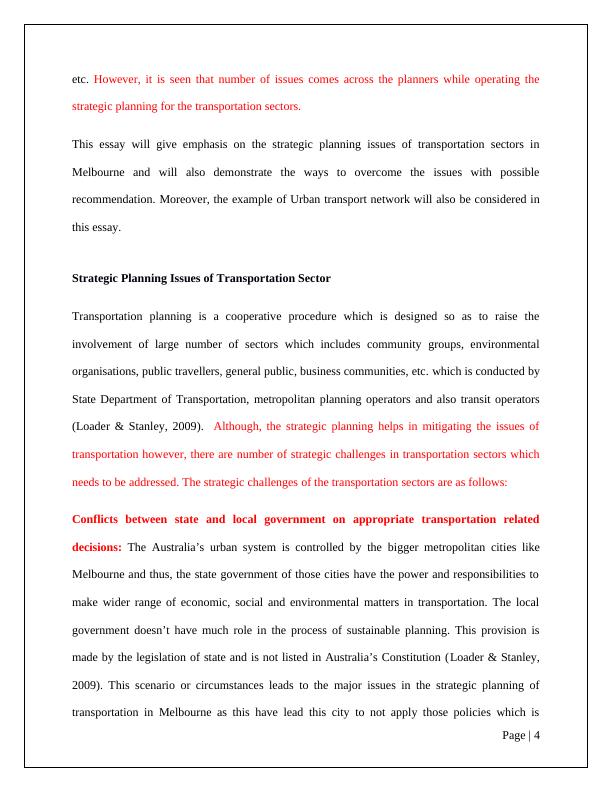Strategic Planning Issues of Transportation Sector in Melbourne
Added on 2023-04-04
15 Pages3539 Words53 Views
Strategic Planning Issues of Transportation Sector in Melbourne
Name:
Tutor’s Name:
Date:
Name:
Tutor’s Name:
Date:

Table of Contents
Introduction......................................................................................................................................3
Strategic Planning Issues of Transportation Sector.........................................................................4
Strategic Planning Decision on the Issues.......................................................................................5
Solution to Address the Strategic Planning Issues..........................................................................6
Challenges Encountered While Addressing the Strategic Planning Issues.....................................8
Recommendation to Address the Strategic Planning Issues............................................................9
Urban Transport System strategic plan of Melbourne...................................................................10
Conclusion.....................................................................................................................................12
References......................................................................................................................................14
Page | 2
Introduction......................................................................................................................................3
Strategic Planning Issues of Transportation Sector.........................................................................4
Strategic Planning Decision on the Issues.......................................................................................5
Solution to Address the Strategic Planning Issues..........................................................................6
Challenges Encountered While Addressing the Strategic Planning Issues.....................................8
Recommendation to Address the Strategic Planning Issues............................................................9
Urban Transport System strategic plan of Melbourne...................................................................10
Conclusion.....................................................................................................................................12
References......................................................................................................................................14
Page | 2

Introduction
Traffic on roads is one of the symbol of the freedom of movement and also dynamic economy.
The higher traffic in the city demonstrates that the financial condition of the citizen of that place
is stronger to purchase the vehicles and thus reflects the economic growth of the place. However,
higher congestion or traffic results into various unwanted results and outcomes which includes
environmental pollution, extra running costs of the vehicles, failure in achieving productivity,
lesser prediction regarding the travel times and also increased difficulties in reaching at
workplace at desired time period (Freestone, 2010). The Victorian competition and Efficiency
Commission had calculated the cost spend in Melbourne’s traffic in 2006 to be $1.3 billion to
$2.6 billion annually and expected to get doubled by 2020. The development and growth over
past one decades have illustrated that Melbourne is facing major traffic congestion issues
(Infrastructure Australia, 2012). People are seen spending longer time in traffic mainly on the
peak morning and evening hours.
The traffic is even more severe in the inner Melbourne which connects the ways for schools and
workplace. Congestion is mainly the cause of supply and demand-side factors so effective
strategic management plan is needed to addressing of the issues (Infrastructure Australia, 2012).
There can be reduction of the traffic by executing demand management which encourages the
minimizing of the travel of the car at the peak hours. The Department of Transport(DOT) possess
the responsibility so as to lead the strategic policies, make a plan and manage the Melbourne’s
traffic congestion which is also under the Transport Integration Act 2010(Freestone, 2010).
There are numerous other agencies which also plays major role so as manage the traffic such as
VicRoads, Public Transport Victoria, Department of Planning and Community Development,
Page | 3
Traffic on roads is one of the symbol of the freedom of movement and also dynamic economy.
The higher traffic in the city demonstrates that the financial condition of the citizen of that place
is stronger to purchase the vehicles and thus reflects the economic growth of the place. However,
higher congestion or traffic results into various unwanted results and outcomes which includes
environmental pollution, extra running costs of the vehicles, failure in achieving productivity,
lesser prediction regarding the travel times and also increased difficulties in reaching at
workplace at desired time period (Freestone, 2010). The Victorian competition and Efficiency
Commission had calculated the cost spend in Melbourne’s traffic in 2006 to be $1.3 billion to
$2.6 billion annually and expected to get doubled by 2020. The development and growth over
past one decades have illustrated that Melbourne is facing major traffic congestion issues
(Infrastructure Australia, 2012). People are seen spending longer time in traffic mainly on the
peak morning and evening hours.
The traffic is even more severe in the inner Melbourne which connects the ways for schools and
workplace. Congestion is mainly the cause of supply and demand-side factors so effective
strategic management plan is needed to addressing of the issues (Infrastructure Australia, 2012).
There can be reduction of the traffic by executing demand management which encourages the
minimizing of the travel of the car at the peak hours. The Department of Transport(DOT) possess
the responsibility so as to lead the strategic policies, make a plan and manage the Melbourne’s
traffic congestion which is also under the Transport Integration Act 2010(Freestone, 2010).
There are numerous other agencies which also plays major role so as manage the traffic such as
VicRoads, Public Transport Victoria, Department of Planning and Community Development,
Page | 3

etc. However, it is seen that number of issues comes across the planners while operating the
strategic planning for the transportation sectors.
This essay will give emphasis on the strategic planning issues of transportation sectors in
Melbourne and will also demonstrate the ways to overcome the issues with possible
recommendation. Moreover, the example of Urban transport network will also be considered in
this essay.
Strategic Planning Issues of Transportation Sector
Transportation planning is a cooperative procedure which is designed so as to raise the
involvement of large number of sectors which includes community groups, environmental
organisations, public travellers, general public, business communities, etc. which is conducted by
State Department of Transportation, metropolitan planning operators and also transit operators
(Loader & Stanley, 2009). Although, the strategic planning helps in mitigating the issues of
transportation however, there are number of strategic challenges in transportation sectors which
needs to be addressed. The strategic challenges of the transportation sectors are as follows:
Conflicts between state and local government on appropriate transportation related
decisions: The Australia’s urban system is controlled by the bigger metropolitan cities like
Melbourne and thus, the state government of those cities have the power and responsibilities to
make wider range of economic, social and environmental matters in transportation. The local
government doesn’t have much role in the process of sustainable planning. This provision is
made by the legislation of state and is not listed in Australia’s Constitution (Loader & Stanley,
2009). This scenario or circumstances leads to the major issues in the strategic planning of
transportation in Melbourne as this have lead this city to not apply those policies which is
Page | 4
strategic planning for the transportation sectors.
This essay will give emphasis on the strategic planning issues of transportation sectors in
Melbourne and will also demonstrate the ways to overcome the issues with possible
recommendation. Moreover, the example of Urban transport network will also be considered in
this essay.
Strategic Planning Issues of Transportation Sector
Transportation planning is a cooperative procedure which is designed so as to raise the
involvement of large number of sectors which includes community groups, environmental
organisations, public travellers, general public, business communities, etc. which is conducted by
State Department of Transportation, metropolitan planning operators and also transit operators
(Loader & Stanley, 2009). Although, the strategic planning helps in mitigating the issues of
transportation however, there are number of strategic challenges in transportation sectors which
needs to be addressed. The strategic challenges of the transportation sectors are as follows:
Conflicts between state and local government on appropriate transportation related
decisions: The Australia’s urban system is controlled by the bigger metropolitan cities like
Melbourne and thus, the state government of those cities have the power and responsibilities to
make wider range of economic, social and environmental matters in transportation. The local
government doesn’t have much role in the process of sustainable planning. This provision is
made by the legislation of state and is not listed in Australia’s Constitution (Loader & Stanley,
2009). This scenario or circumstances leads to the major issues in the strategic planning of
transportation in Melbourne as this have lead this city to not apply those policies which is
Page | 4

End of preview
Want to access all the pages? Upload your documents or become a member.
Related Documents
CIV4ID Infrastructure Design: Traffic Analysis and Recommendationslg...
|11
|2442
|125
Public Transport and Traffic Congestion in Jeddahlg...
|27
|6528
|80
Contemporary Design: Cycling as a Solution to Social and Environmental Challengeslg...
|13
|2685
|317
Managerial Economics: Allocation of Resources, Social Cost of Cars, Tax on Petrol, Subsidies for Bus Travellg...
|16
|3870
|98
Project Plan : Sample Assignmentlg...
|7
|1077
|19
Integrated Infrastructure Project Managementlg...
|8
|1568
|203
